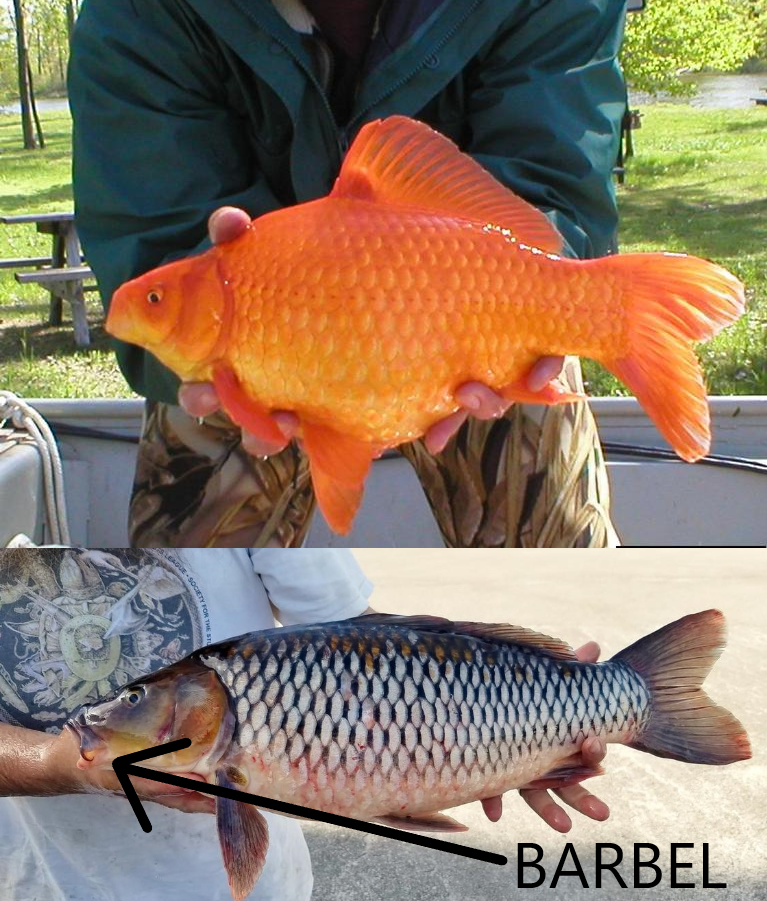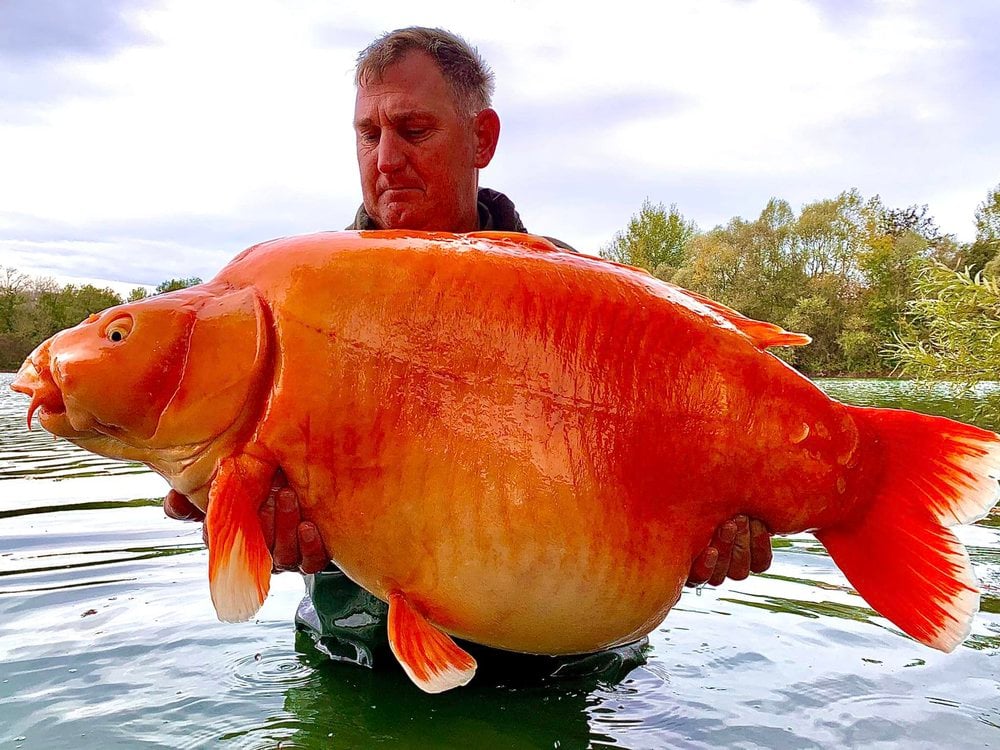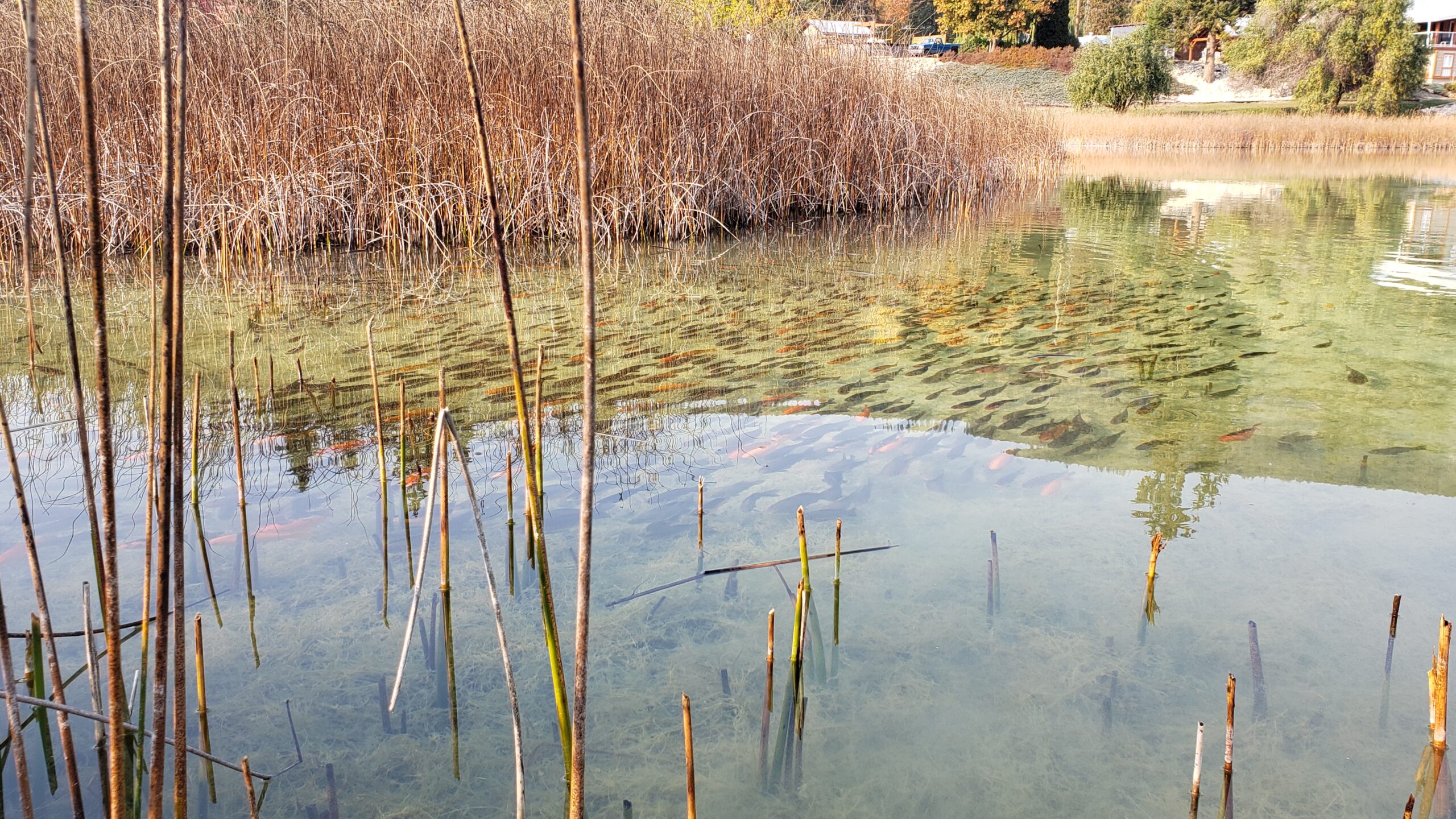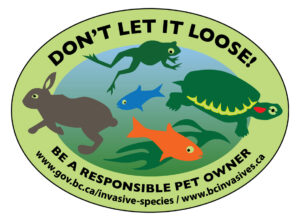FOUND IN B.C.? Yes. They are found in lakes and waterways across B.C., including White Lake and Little White Lake (near Salmon Arm), Dragon Lake (Quesnel), Lost Lake (Terrace), as well as other waterbodies in the Fraser Valley and Okanagan region.
Goldfish are one of the most widespread invasive fish. While they seem like the perfect pet, they can be quite destructive when they are released into the wild!
Identification
Despite their name, not all goldfish (Carassius auratus) may appear gold! Pet goldfish are gold because brightly-coloured carp were selectively bred as ornamental fish for thousands of years. As they breed and mature in the wild, the colours of released goldfish can change across generations, often appearing more grey or olive-coloured, but can also show mixes of red, white and black.
The sizes of released goldfish can also vary greatly. In the wild, they were typically grow much larger (13-26 cm) than in captivity. The body of the goldfish will be covered in scales, but the head will not. They have a long dorsal (back) fin and most goldfish will have a deeply forked caudal fin (tail). There are cases of goldfish growing up to 40 cm long! Unlike some related carp and koi species, goldfish do not have barbels (AKA whiskers) on the mouths.

Top: Goldfish, no barbels at mouth. Bottom: Common carp, barbels present at mouth.
Life Cycle
A female can lay anywhere from 100 to 50,000 eggs per season. When the eggs are laid, they will stick to rocks and plants. The eggs will hatch in 2-7 days after fertilization. Interestingly, some female goldfish can reproduce asexually – this means that their eggs do not require fertilization and the eggs will hatch into identical clones of the mother. Most goldfish will live between 5-15 years.
Ecology
Goldfish can survive in almost any freshwater waterbody – they are incredibly resilient! But they prefer to live in shallow and slow-moving lakes and ponds with lots of aquatic vegetation. They can tolerate a wide range of environmental conditions – including anoxic water and temperatures between 0-41C°! They are omnivorous fish and will feed on small invertebrates, like snails and insects, as well as plants.

A 67-pound fish caught in a stocked lake in France
Introduction and Spread
Goldfish are native to eastern Asia. A quintessential pet fish, they are available worldwide in the pet and aquarium industry. However, they have been released as unwanted pets which has led to their introduction and spread across the world outside of their native range.
New populations of goldfish seem to be appearing every year across B.C. There are well known populations in waterbodies in the Fraser and Okanagan valleys and Whistler area, in White Lake and Little White Lake near Salmon Arm, Dragon Lake near Quesnel and in Lost Lake near Terrace. The populations that exist across B.C. are primarily from released pets.
Recently, there have been large efforts to removal goldfish from some lakes in B.C. Electrofishing is a method used to salvage or remove fish from a waterbody by passing an electric current through the water to temporarily stun fish so that they can be caught with a net. It can be an effective method, however, it is also an expensive one. Electrofishing has been used to remove goldfish in White Lake and more recently at Dragon Lake.

Large school of goldfish at Little White Lake near Salmon Arm, B.C. in 2022
Impacts
When goldfish feed, they stir up the muddy or sandy lake bottoms which causes the water to become cloudy and turbid. Higher levels of turbidity negatively affect the growth of surrounding aquatic plants. Lack of plant life in a lake can lead to lower oxygen levels, which are tolerable by goldfish but negatively affecting local fish species.
Like many other invasive fish species, goldfish will not only compete with native species for food but they can also predate on eggs of the native fish. Goldfish share a similar diet to trout and increased competition can decrease trout stocks in some lakes. Goldfish do not have many predators, particularly when they reach such a large size, and so their populations can quickly grow large and overwhelm ecosystems. Goldfish can also carry diseases that can be passed onto local fish populations.
What Can We Do?
DON’T LET IT LOOSE: As humans, we are the number one vector of spread for invasive species but we can also play an important role in stopping new invasions and infestations. Making slight changes to some of our behaviours is key to preventing and managing the spread of invasive species. The most important step you can take to prevent the spread of goldfish is to be a responsible pet owner. This means that we understand and accept the responsibility of owning a pet and Don’t Let It Loose to the wild when the pet is longer wanted or can no longer be cared for. Before purchasing or adopting any pet, consider how you will take care of it for its entire lifespan. If you are longer able to care for a pet, contact rescue centres or other resources in your community to attempt to re-home your pet. Euthanization of the pet will be the last resort approach to dealing with a pet that can no longer be cared for, which is why it is really important to understand the long-term needs of the pet before ownership. This practice also applies to plants that we may have in our terrariums, aquariums or ponds as well.
REPORT: Report all sightings of invasive species online or on the ReportInvasives mobile app.
REMEMBER: It is illegal to transfer live fish between waterbodies in B.C. The use of live finfish as bait is prohibited in B.C.
Literature and Resources
https://bcinvasives.ca/wp-content/uploads/2021/11/DLIL-Goldfish-FS-inreview.pdf